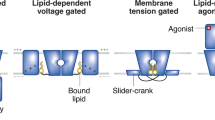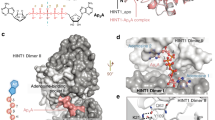Abstract
The activation of cellular function following the direct introduction of Ca2+ into the cytosol by the use of a Ca2+ transporting ionophore has served to confirm the widely held idea that Ca2+ has the status of a second messenger in many cell types1,2. However, this evidence has been obtained largely from the use of a single ionophore, the antibiotic A23187; experiments with X537A, which is another ionophorous antibiotic capable of transporting Ca2+ (ref. 3), have failed to show the expected characteristics. For example, histamine release from rat mast cells mediated by X537A is neither dependent on extracellular Ca2+ nor prevented by metabolic inhibitors4. Ionomycin is a recently described polyether antibiotic produced by Streptomyces conglobatus ATCC 31005, and is active against Grampositive bacteria5. The antibiotic action is presumably due to its ionophorous properties, as it extracts Ca2+ from an aqueous phase into an organic phase with a stoichiometry of 1:1 (ref. 6). The ionophore is also capable of transporting 45Ca2+ across biological membranes (our unpublished results). Here we report the application of ionomydn to rat mast cells. We show that ionomycin stimulates mast cell secretion solely through its ability to form a lipid-soluble calcium complex, and thus to convey Ca2+ across the hydrocarbon region of the cell membrane.
This is a preview of subscription content, access via your institution
Access options
Subscribe to this journal
Receive 51 print issues and online access
$199.00 per year
only $3.90 per issue
Buy this article
- Purchase on Springer Link
- Instant access to full article PDF
Prices may be subject to local taxes which are calculated during checkout
Similar content being viewed by others
References
Gomperts, B. D. The Plasma Membrane: Models for Structure and Function (Academic, London, 1977).
Gomperts, B. D. in Receptors and Recognition Vol. 2A (eds Cuatrecasas, P. & Greaves, M. F.) 43–102 (Chapman and Hall, London, 1976).
Pressman, B. C. Fedn Proc. 32, 1698–1703 (1973).
Foreman, J. C., Mongar, J. L. & Gomperts, B. D. Nature 245, 249–251 (1973).
Liu, W.-C. et al. J. Antibiot. 31, 815–819 (1978).
Liu, C.-M. & Hermann, T. E. J. biol. Chem. 253, 5892–5894 (1978).
Pressman, B. C. Fedn Proc. 27, 1283–1288 (1968).
Young, S. P. & Gomperts, B. D. Biochim. biophys. Acta 469, 281–291 (1977).
Grell, E. & Funck, T. J. supramolec. struct. 1, 307–335 (1973).
Feinstein, M. B. & Felsenfeld, H. Proc. natn. Acad. Sci. U.S.A. 68, 2037–2041 (1971).
Baker, P. F. Symp. Soc. exp. Biol. 30, 67–88 (1976).
Baker, P. F. & Whitaker, M. J. Nature 276, 513–515 (1978).
Allen, D. G. & Blinks, J. R. Nature 273, 509–513 (1978).
Lawson, D., Fewtrell, C. & Raff, M. C. J. Cell Biol. 79, 394–400 (1978).
Cockcroft, S. & Gomperts, B. D. J. Physiol., Lond., 296, 229–243 (1979).
Author information
Authors and Affiliations
Rights and permissions
About this article
Cite this article
Bennett, J., Cockcroft, S. & Gomperts, B. Ionomycin stimulates mast cell histamine secretion by forming a lipid-soluble calcium complex. Nature 282, 851–853 (1979). https://doi.org/10.1038/282851a0
Received:
Accepted:
Issue Date:
DOI: https://doi.org/10.1038/282851a0
This article is cited by
-
Connective tissue mast cells store and release noradrenaline
The Journal of Physiological Sciences (2023)
-
HCO3 −-dependent transient acidification induced by ionomycin in rat submandibular acinar cells
The Journal of Physiological Sciences (2010)
-
Protein kinase C‐α mediates TNF release process in RBL‐2H3 mast cells
British Journal of Pharmacology (2005)
-
Effects of the divalent cation ionophore ionomycin on the performance of isolated guinea-pig atria
Basic Research in Cardiology (1990)
-
Deliberate quin2 overload as a method forIn Situ characterization of active calcium extrusion systems and cytoplasmic calcium binding: application to the human platelet
The Journal of Membrane Biology (1988)
Comments
By submitting a comment you agree to abide by our Terms and Community Guidelines. If you find something abusive or that does not comply with our terms or guidelines please flag it as inappropriate.



